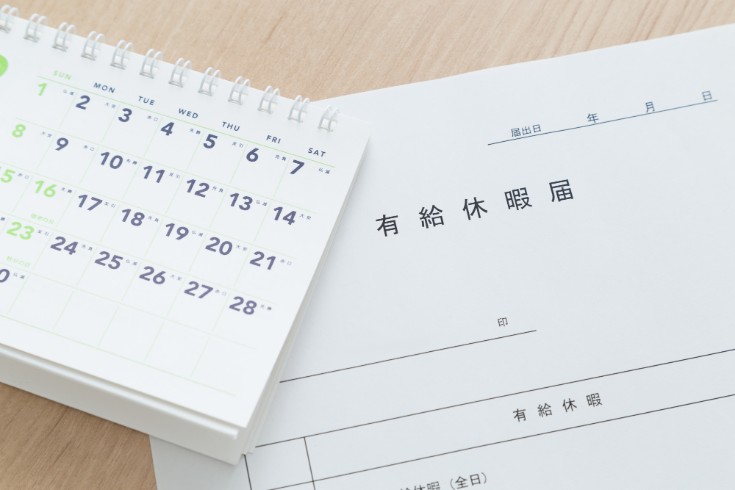Legal Framework and Practical Responses to Annual Paid Leave in Japanese Labor Law

Under Japanese labor law, annual paid leave is a fundamental right granted to workers. This system aims to allow workers to recover from physical and mental fatigue and lead fulfilling social lives. From a business management perspective, understanding and properly implementing the annual paid leave system is not merely a matter of employee welfare; it is a crucial duty that forms the core of legal compliance and labor risk management. Managers face a wide range of challenges. Specifically, they must accurately calculate the number of paid leave days granted to each employee, appropriately balance employees’ leave requests with the operational needs of the business, and ensure compliance with the mandatory five-day leave acquisition introduced in 2019. These responsibilities also involve related administrative tasks and financial considerations. This article provides a comprehensive explanation of the legal framework for the annual paid leave system based on the Japanese Labor Standards Act and related case law. We will systematically organize and explain practical issues that companies face, including the requirements for granting leave, the rights and obligations of employers and employees, strategic management methods such as the planned leave system, and the legal consequences of violating the law.
Requirements and Number of Days for Annual Paid Leave in Japan
The basis for annual paid leave is stipulated in Article 39 of the Japanese Labor Standards Act. Unlike discretionary leave systems established by companies, this is a legal obligation imposed on employers. To be eligible for their first annual paid leave, workers must meet two requirements set by law.
The first requirement is continuous service. Workers must have been continuously employed for a period of six months from the date of hire. The second requirement is attendance rate. Workers must have attended at least 80% of all working days during those six months. Employers are then principally required to grant 10 working days of annual paid leave to those workers who meet these requirements.
After the initial grant, the number of annual paid leave days increases with the length of continuous service. For regular workers, 10 working days are granted after six months of continuous service, and with each passing year, the number of granted days increases, reaching a maximum of 20 working days for those with over 6 years and 6 months of service.
On the other hand, part-time workers and those with shorter prescribed working days or hours are also entitled to annual paid leave. However, the number of days is determined proportionally based on factors such as the number of prescribed working days per week. This proportional grant applies to workers whose prescribed working hours are less than 30 hours per week, and who have less than 4 prescribed working days per week or less than 216 prescribed working days per year. The specific number of granted days is as follows.
| Prescribed Working Days per Week | Prescribed Working Days per Year | Years of Continuous Service | 0.5 Year | 1.5 Years | 2.5 Years | 3.5 Years | 4.5 Years | 5.5 Years | Over 6.5 Years |
| 4 Days | 169 to 216 Days | Granted Days | 7 Days | 8 Days | 9 Days | 10 Days | 12 Days | 13 Days | 15 Days |
| 3 Days | 121 to 168 Days | Granted Days | 5 Days | 6 Days | 6 Days | 8 Days | 9 Days | 10 Days | 11 Days |
| 2 Days | 73 to 120 Days | Granted Days | 3 Days | 4 Days | 4 Days | 5 Days | 6 Days | 6 Days | 7 Days |
| 1 Day | 48 to 72 Days | Granted Days | 1 Day | 2 Days | 2 Days | 2 Days | 3 Days | 3 Days | 3 Days |
There are also provisions regarding the carryover and statute of limitations for annual paid leave. Workers can carry over unused annual paid leave to the following year, but according to Article 115 of the Japanese Labor Standards Act, the right to take annual paid leave expires two years after it accrues.
By legal principle, annual paid leave is granted based on each worker’s date of hire, resulting in different “reference dates” for each worker. This can be a particularly complex management issue for companies with many employees. It requires tracking each employee’s reference date individually, calculating the number of granted days, and managing the mandatory acquisition period of five days per year, leading to increased management costs and the risk of calculation errors. To address this challenge, some companies have adopted a method called “uniform treatment.” This involves standardizing the reference date for annual paid leave for all employees to a specific date, such as April 1st each year. By adopting this method, the management of annual paid leave can be consolidated into an annual task, improving efficiency and reducing errors. However, when introducing this system, it is essential to ensure that it does not disadvantage workers. For example, workers who join the company in the latter half of the fiscal year should be granted leave in advance of the statutory reference date, ensuring that the system does not fall below the minimum standards set by law. Thus, the unification of the reference date should be considered not just as an administrative procedure change but as part of a strategic labor management approach that assumes compliance with legal requirements.
The Right of Workers to Specify the Timing of Paid Leave and the Employer’s Right to Change the Timing Under Japanese Law
In Japan, the acquisition of annual paid leave involves a crossroads between the rights of workers and the operational needs of employers. The Japanese Labor Standards Act provides a mechanism to balance these interests.
As a basic principle, workers have the right to take their annual paid leave during the season they desire, known as the “right to specify the timing” of their leave. Workers are not obligated to explain the reasons for their leave to the employer, and employers, in principle, cannot refuse their application.
However, there is one exception to this right of workers: the employer’s “right to change the timing.” According to Article 39, Paragraph 5 of the Japanese Labor Standards Act, employers may change the timing of the paid leave to another season only if granting leave during the requested period would “impede the normal operation of the business.”
The requirement that the leave must “impede the normal operation of the business” is interpreted very strictly. Reasons such as the workplace being busy or difficulty in securing substitute personnel do not justify the exercise of the right to change the timing. Court precedents have determined that various circumstances should be objectively considered, such as the nature of the worker’s duties, the busyness of the work, the difficulty of securing a substitute, and the number of other workers who have applied for leave on the same day. Importantly, before exercising the right to change the timing, employers have a duty to make every possible consideration to allow workers to take leave as they wish, such as arranging substitute workers or adjusting work schedules.
The Supreme Court of Japan has set a high bar for the exercise of the right to change the timing through past precedents. For instance, in cases such as the Denden Koshiro Telegraph and Telephone Office case (Supreme Court judgment on March 18, 1982) and the Hirosaki Telegraph and Telephone Office case (Supreme Court judgment on July 10, 1987), it has been indicated that employers can exercise the right to change the timing only in very limited situations, such as when securing substitute personnel is objectively difficult.
A recent case of note is the East Japan Railway Company case (Tokyo High Court judgment on February 28, 2024). In this case, the company’s exercise of the right to change the timing of a Shinkansen train driver’s application for annual paid leave was deemed lawful. The court’s decision was based on the high level of specialization and importance of safety in the train driver’s duties, the extreme difficulty in securing substitute personnel, and the company’s efforts to plan personnel placement through fair operational rules such as a system for determining the order of leave entitlement. This precedent suggests that the exercise of the right to change the timing may be permitted in special industries like public transportation, which are socially critical infrastructures and where substituting the work is difficult, provided that the employer has established a planned and fair labor management system.
The exercise of the right to change the timing in response to applications for long-term leave from workers planning to resign can also be a point of contention. In principle, there is no room to set an alternative date for those planning to resign, so the exercise of the right to change the timing is not permitted. However, in the R Company case (Tokyo District Court judgment on January 19, 2009), this was exceptionally allowed. The background of this case involved the worker being responsible for an important project, with the handover of duties not yet completed, and their absence would have caused serious disruption to the business. This precedent indicates that the exercise of the right to change the timing is not absolutely impossible even for those planning to resign, but it is limited to cases where there are objective and significant reasons, such as when the handover of duties is essential and cannot be performed without that worker.
What emerges from these precedents is that the exercise of the right to change the timing is not merely a right of the employer but rather a situation that questions the employer’s labor management capabilities. Simple claims such as “it’s a busy period” do not hold up legally. The courts question what concrete efforts the employer has made to fulfill the workers’ leave requests. Chronic staff shortages do not justify the right to change the timing; instead, they are seen as a management issue. Therefore, when considering the exercise of the right to change the timing, it is crucial to ensure that the decision can withstand judicial scrutiny, meaning that the employer must practice planned labor management, such as securing substitute personnel and leveling workloads, on a regular basis.
Mandatory Acquisition of Annual Paid Leave Days in Japan
Significant changes to the annual paid leave system were introduced with the amendment of the Japanese Labor Standards Act, which came into effect on April 1, 2019 (Heisei 31). This amendment mandates all employers to ensure that eligible workers take at least five days of annual paid leave .
The obligation applies to all workers who are granted 10 or more days of annual paid leave in the fiscal year. This includes managers, fixed-term employees, and part-time workers who reach 10 days of leave through proportional entitlement .
Employers must fulfill this obligation within one year from the date annual paid leave is granted, referred to as the “standard date” . During this one-year period, employers must ensure that the eligible workers have taken at least five days of annual paid leave.
The essence of this system lies in the proactive involvement of the employer, namely the “designation of time obligation.” Initially, employers should encourage workers to take leave at their preferred times. However, if the worker has not taken at least five days of leave by the end of the year from the standard date, the employer is obligated to designate the timing for the remaining days. Nevertheless, employers cannot unilaterally decide the dates; they must first listen to the workers’ opinions and strive to respect their wishes as much as possible when designating the timing.
With this obligation comes a new administrative duty for employers. Specifically, they must create an “Annual Paid Leave Ledger” for each worker, recording the standard date, the dates leave was taken, and the remaining days, and preserve these records for three years (although the amendment requires preservation for five years, a transitional measure currently applies this for three years).
It is important to note that while half-day leaves can be counted as 0.5 days towards the mandatory five days of leave, leave taken in hourly increments cannot be included in the calculation .
Failure to comply with this obligation can result in penalties for employers. A fine of up to 300,000 yen per worker may be imposed .
This legal revision signifies a paradigm shift in Japan’s annual paid leave system. Previously, the low rate of paid leave acquisition was often perceived as an issue of individual workers’ reluctance or workplace culture. However, the 2019 amendment transformed the acquisition of leave from a “worker’s right” to an “employer’s obligation.” Employers are no longer just entities that grant leave; they now bear the responsibility of managing and ensuring that the leave is actually taken. As a result, the management of annual paid leave has evolved from a mere aspect of labor management to a significant compliance issue with penal provisions, and ultimately, an integral part of corporate governance.
Planned Allocation System for Annual Paid Leave Under Japanese Labor Standards Law
To encourage the acquisition of annual paid leave and simultaneously enhance the planning of business operations, the Japanese Labor Standards Act has established a “planned allocation system.” This system allows for a predetermined allocation of certain days of annual paid leave through a labor-management agreement between the employer and the workers’ representative.
The legal basis for this system is found in Article 39, Paragraph 6 of the Japanese Labor Standards Act. The most crucial requirement for introducing the planned allocation system is to ensure that workers retain a number of days that they can freely use for personal emergencies or illness. Therefore, at least five days of the annual paid leave each worker is entitled to must be left available for the worker to freely designate the timing. Only the days exceeding these five can be subject to planned allocation.
The procedure for implementing the system consists of two stages. First, it is necessary to include a provision in the work rules stating that annual paid leave may be granted on a planned basis through a labor-management agreement. Then, a written labor-management agreement detailing the specific method of allocation must be concluded with either a labor union representing the majority of workers or, if there is no union, a representative of the majority of workers. There is no need to notify the local Labor Standards Inspection Office of this labor-management agreement.
There are mainly three models for the practical operation of planned allocation. The first is the “simultaneous grant method,” where all workers in the workplace take leave on the same day. This method is often used in manufacturing plants to align with summer or year-end and New Year holidays, creating extended breaks.
The second is the “rotational grant method,” which allows groups such as departments or teams to take turns taking leave. This method is suitable for industries like retail and services, where it is difficult to completely halt operations.
The third is the “individual grant method,” where an annual leave acquisition plan is created for each worker, and leave is granted accordingly. This allows for flexible operation, such as incorporating personal anniversaries (birthdays, wedding anniversaries, etc.) into the plan in advance.
The aforementioned obligation to take at least five days of leave has further heightened the strategic importance of the planned allocation system. While it was once seen as one of the voluntary measures to improve the leave acquisition rate, it has now become a primary means to efficiently and strategically fulfill the legal obligation of taking five days. For example, if a company sets three days of company-wide leave, it ensures that many employees have fulfilled three of the mandatory five days. This significantly reduces the management burden of tracking individual employees’ leave acquisition and encouraging leave taking. Moreover, as the leave acquisition days are predetermined, it becomes easier to plan work schedules, and the predictability of business operations improves. Thus, the obligation to take five days of leave and the planned allocation system are not separate but complement each other. For managers, viewing these two systems as an integrated whole and actively utilizing the planned allocation system is key to achieving compliance and efficient labor management.
Calculating Wages During Annual Paid Leave Periods Under Japanese Labor Standards Law
Annual paid leave, as the name suggests, is a ‘paid’ vacation, and employers are obligated to pay wages even for the days when employees take leave. Article 39, Paragraph 9 of the Japanese Labor Standards Act stipulates three methods for calculating these wages, and employers must select one of these methods and clearly state it in their work rules.
The first method is to pay the ‘usual wages.’ This means paying the wages that the worker would have earned if they had worked the prescribed working hours on that day, which is the most common and straightforward method. For salaried workers, this usually means no change in their monthly salary. For hourly workers, the amount paid is the hourly wage multiplied by the number of prescribed working hours for that day.
The second method is to pay the ‘average wage.’ This method involves dividing the total wages paid to the worker over the three months prior to the day the annual paid leave is taken by the total number of days in that period (calendar days) to calculate the daily wage. This method is used for workers with variable wages, but it can be somewhat complicated to calculate. There is also a calculation for a minimum guaranteed amount to prevent the wage from becoming significantly low due to the number of working days.
The third method is to pay the ‘standard remuneration daily amount.’ This is calculated by dividing the standard remuneration monthly amount, as defined by the Health Insurance Law, by 30. This method has the advantage of being simple to calculate, but it requires a labor-management agreement to be concluded in advance.
Each of these three methods has its own personalityistics, and the calculated wage amounts may differ. The following table compares the methods.
| Comparison Item | Usual Wages | Average Wages | Standard Remuneration Daily Amount |
| Calculation Method | Wages paid for working the prescribed hours | Amount obtained by dividing the total wages of the last three months by the total number of days in that period | Amount obtained by dividing the standard remuneration monthly amount by 30 |
| Ease of Management | Most straightforward | Complicated | Relatively simple |
| Employer’s Cost Burden | Tends to be higher | Tends to be lower | Variable (usually lower than usual wages) |
| Legal Requirements | Stipulation in work rules | Stipulation in work rules | Stipulation in work rules and conclusion of a labor-management agreement |
Choosing which calculation method to use is not merely an administrative decision. It is a management judgment made after considering three elements: personnel costs, administrative costs, and the relationship with employees. ‘Usual wages’ are the most understandable and transparent method for employees, but they can be the most costly for the company. ‘Average wages’ may help control personnel costs, but the calculation is complex, increasing the burden of management and the risk of calculation errors. The ‘standard remuneration daily amount’ strikes a balance between ease of management and cost control, but it requires the additional procedure of concluding a labor-management agreement. Therefore, companies are required to strategically select the most suitable method according to the realities of their salary system and labor management structure.
Prohibition of Disadvantageous Treatment for Taking Annual Paid Leave Under Japanese Law
The Japanese Labor Standards Act ensures that workers have the substantive right to take annual paid leave by prohibiting employers from obstructing the exercise of this right. At the heart of this is Article 136 of the Supplementary Provisions of the Japanese Labor Standards Act. This article stipulates that employers must not reduce wages or otherwise treat workers disadvantageously for taking annual paid leave.
The term “disadvantageous treatment” is interpreted broadly. It includes not only direct wage reductions but also unfavorable evaluations in bonus and salary increase assessments, non-payment of perfect attendance allowances, negative evaluations in personnel assessments, and disadvantageous job transfers. For example, treating the day when annual paid leave is taken as an absence and using it as a reason to withhold a perfect attendance allowance or reduce a bonus would, in principle, potentially violate this provision.
However, there is an important point to note about the legal nature of Article 136. In legal interpretation, this provision is considered a “duty of effort” and does not directly impose penalties for violations. Moreover, corporate measures that contravene this provision are not immediately invalid under private law.
So, when can a company’s measures be deemed illegal? The judiciary has set a standard that measures are considered to violate public order and morals and are invalid if they are recognized as substantially undermining the purpose of the annual paid leave system.
This standard was concretely demonstrated in the Numazu Transportation case (Supreme Court judgment on June 25, 1993 (1993)). In this case, an employment regulation that did not pay a perfect attendance allowance when annual paid leave was taken was contested. The Supreme Court held that the degree of disadvantage, such as the non-payment of the perfect attendance allowance, and the actual deterrent effect it had on workers’ acquisition of annual paid leave should be comprehensively considered. The Court ruled the provision valid, as the amount of the perfect attendance allowance was relatively small and its non-payment did not significantly suppress the workers’ vacation acquisition.
What can be derived from this case law is that the legality of disadvantageous treatment is judged based on the “degree” and “balance” of the measure. There may seem to be a contradiction between the wording of the law and the actual judicial decisions, but this reflects the stance that the law does not set uniform standards but evaluates the substantive impact on a case-by-case basis. In other words, if a company’s system is deemed to have a minor economic disadvantage to workers and does not substantially hinder the exercise of the right to take leave, there is room for it to be considered legal. Conversely, systems that impose a significant disadvantage and make workers hesitant to take leave, even if indirect, are more likely to be judged illegal and invalid.
Therefore, managers and HR personnel need to review their company’s systems not just from the formal question of “Is this system permissible?” but from the substantive perspective of “Is the disadvantage this system imposes strong enough to deter workers from taking leave?” When incorporating attendance elements into the calculation criteria for bonuses and allowances, it is essential to carefully evaluate the balance to ensure that the measures do not render the right to annual paid leave meaningless, as this is crucial to avoid legal risks.
Summary
Annual paid leave is a complex and crucial system established under Japanese labor law. Employers are tasked with a wide range of legal duties, from accurately calculating and granting the number of days of leave for each employee to ensuring the fulfillment of the obligation to take at least five days off per year, and further, to avoid any disadvantageous treatment due to the taking of leave. To comply with these obligations, a deep understanding of the legislation is essential, as is the establishment of a strategic and planned labor management system, including the use of a planned leave granting system.
Monolith Law Office has a track record of providing extensive advice on complex issues related to Japanese labor law to a diverse range of clients, both domestic and international. Our firm offers all legal support related to the annual paid leave system, including the creation and revision of work rules, the introduction of planned leave systems, and representation in labor disputes, ensuring that our clients’ HR practices comply with the latest laws and case law. Additionally, our firm includes several English-speaking attorneys, some of whom are qualified in foreign jurisdictions. This unique structure enables us to provide clear and accurate legal services to foreign companies operating in Japan, overcoming differences in legal systems and business cultures. If you have any inquiries regarding the operation of the annual paid leave system or other aspects of Japanese labor law, please do not hesitate to contact our office.
Category: General Corporate





















